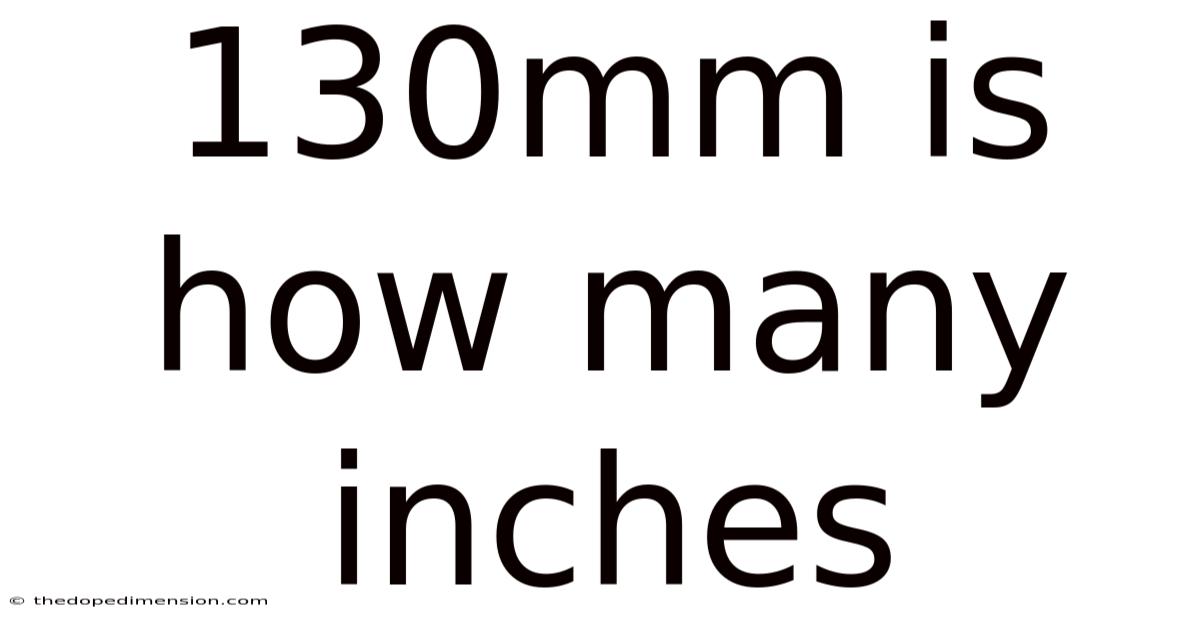130mm Is How Many Inches
thedopedimension
Aug 26, 2025 · 4 min read

Table of Contents
130mm is How Many Inches? A Comprehensive Guide to Metric-Imperial Conversions
Knowing how to convert between metric and imperial units is a crucial skill in many fields, from engineering and manufacturing to cooking and everyday life. This comprehensive guide will delve into the conversion of 130 millimeters (mm) to inches (in), explaining the process, providing the answer, exploring the underlying principles, and addressing common questions. Understanding this conversion not only provides a numerical answer but also builds a foundational understanding of unit conversion, a valuable skill across various disciplines.
Introduction: Understanding Metric and Imperial Systems
The world uses two primary systems of measurement: the metric system (also known as the International System of Units or SI) and the imperial system (commonly used in the United States and a few other countries). The metric system is based on powers of 10, making conversions relatively straightforward. The imperial system, however, uses a more complex and less intuitive system of units. This difference often leads to the need for accurate conversion, especially when dealing with dimensions and measurements.
The core of this conversion lies in understanding the fundamental relationship between millimeters and inches. One inch is precisely defined as 25.4 millimeters. This fixed ratio forms the basis of all conversions between these two units.
Step-by-Step Conversion: 130mm to Inches
To convert 130mm to inches, we use the following simple formula:
Inches = Millimeters / 25.4
Substituting the value of 130mm into the formula, we get:
Inches = 130mm / 25.4mm/in ≈ 5.118 inches
Therefore, 130 millimeters is approximately equal to 5.118 inches.
While this provides the direct answer, understanding the underlying principles enhances the comprehension of unit conversion. Let's break it down further.
Detailed Explanation of the Conversion Process
The conversion relies on the established equivalence of 1 inch equaling 25.4 millimeters. This means that for every 25.4 millimeters, there is one inch. To find the number of inches in 130 millimeters, we divide the total millimeters by the number of millimeters in one inch:
130 mm / (25.4 mm/inch) = 5.118 inches (approximately)
The result is approximately 5.118 inches. The use of "approximately" is due to rounding off the decimal places. Depending on the level of precision required, you may choose to round to fewer decimal places (e.g., 5.12 inches).
Significance of Accurate Conversion
Accurate conversion is crucial in various applications:
-
Engineering and Manufacturing: In these fields, even minor discrepancies in measurements can have significant consequences. Accurate conversions ensure precision in design, manufacturing, and quality control.
-
Construction and Architecture: Precise measurements are essential for building structures that are safe, functional, and meet specifications. Converting between metric and imperial units accurately prevents costly errors.
-
Medical and Pharmaceutical Industries: Accurate measurements are paramount for dosages, equipment calibration, and other critical aspects of healthcare.
-
Everyday Applications: While less critical than in specialized fields, accurate conversions are still helpful in various everyday tasks, from cooking (following recipes with different unit systems) to crafting projects.
Beyond the Basic Conversion: Exploring Related Conversions
Understanding the conversion of 130mm to inches opens doors to further exploring related conversions. For example, you can easily convert other millimeter measurements to inches using the same formula. Similarly, you can reverse the formula to convert inches to millimeters:
Millimeters = Inches * 25.4
This allows for flexibility in handling measurements in either system.
Frequently Asked Questions (FAQ)
-
Q: Why is 25.4 the conversion factor between millimeters and inches?
A: The conversion factor 25.4 is a result of the international agreement on defining the inch in terms of the millimeter. This ensures a consistent and universally accepted conversion factor.
-
Q: How can I perform these conversions without a calculator?
A: For quick estimations, you can use approximate conversion factors. For example, 1 inch is roughly equal to 25 millimeters. However, for precise results, using a calculator or conversion tool is recommended.
-
Q: What are some common errors to avoid during conversions?
A: Common errors include:
- Incorrectly using the conversion factor.
- Not paying attention to units (mixing millimeters and centimeters, for example).
- Incorrect rounding of decimal places.
-
Q: Are there online tools available for metric to imperial conversions?
A: Yes, numerous online calculators and conversion tools are readily available. These tools can help ensure accurate and efficient conversions.
Conclusion: Mastering Unit Conversions
Converting 130mm to inches, resulting in approximately 5.118 inches, is a fundamental example of converting between metric and imperial units. Understanding the process involves applying the established conversion factor of 25.4 millimeters per inch. This seemingly simple conversion highlights the importance of accurate measurement and its impact across diverse fields. Mastering unit conversions is not just about obtaining a numerical answer but about developing a deeper understanding of measurement systems and their practical applications. This understanding is crucial for success in various academic, professional, and even everyday scenarios. Remember to always double-check your calculations and consider the level of precision required for your specific application.
Latest Posts
Latest Posts
-
26 Acres To Sq Ft
Aug 26, 2025
-
Mm Cube To Meter Cube
Aug 26, 2025
-
1 Centipoise To Pa S
Aug 26, 2025
-
Kw To Btu H Conversion
Aug 26, 2025
-
1 Bar To Psi Conversion
Aug 26, 2025
Related Post
Thank you for visiting our website which covers about 130mm Is How Many Inches . We hope the information provided has been useful to you. Feel free to contact us if you have any questions or need further assistance. See you next time and don't miss to bookmark.